

Beginner’s guide for journalists who want to understand API documentation. There are three letters that have been floating around the media world for several years now: API.
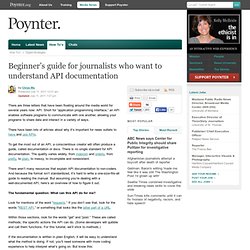
Short for “application programming interface,” an API enables software programs to communicate with one another, allowing your programs to share data and interact in a variety of ways. There have been lots of articles about why it’s important for news outlets to have and use APIs. To get the most out of an API, a conscientious creator will often produce a guide, called documentation or docs. There is no single standard for API documentation. How people use smartphones and tablets and what it means for your mobile strategy.
Nearly half of American adults get some kind of local news or information via a cellphone or tablet.

And as more people adopt portable digital devices, news publishers and other businesses are eager to put their content on these platforms. In doing so, it’s important to recognize that one mobile strategy will not fit all devices. Smartphones and tablets are similar in many ways. Both have touchscreens and apps, and in most cases they even run the same operating systems (iOS or Android). But smartphones and tablets are very different devices when it comes to how people use them. Time to bring back a P.M. news product. Back in 1940, 80% of the 1,877 of the daily newspapers in the United States were published on the afternoon cycle, meaning that editions were printed some time prior to noon for delivery to consumers coming home from work.
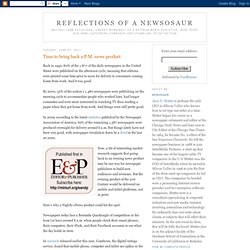
And it was good. By 2000, 52% of the nation’s 1,480 newspapers were publishing on the morning cycle to accommodate people who worked later, had longer commutes and were more interested in watching TV than reading a paper when they got home from work. Why newspapers can’t stop the presses. With newspaper ad sales falling at an unexpectedly abrupt rate, many publishers at mid-year were laying off staff, requiring unpaid furloughs, consolidating plants and taking other measures to buttress their bottom lines.

Although some analysts have interpreted these expense-cutting tactics as a repudiation of the print newspaper business by publishing companies, they are anything but. Publishers have undertaken these measures in an effort to keep their traditional businesses as strong as possible to fund the transition to digital publishing. But they have a long way to go. Fifteen years after the commercial debut of the Internet, publishers on average still depend on print advertising and circulation for 90% of their revenues. Stop the presses and newspaper companies are out of business. There’s no time to lose. Localocracy. EveryBlock San Francisco. The Newsonomics of NPR’s Next-Gen Network. First published at Nieman Journalism Lab Tell me if you’ve heard this one.
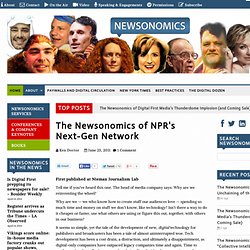
The head of media company says: Why are we reinventing the wheel? Creating a Navigational Guide to New Media. In their new book, “Blur: How to Know What’s True in the Age of Information Overload,” Bill Kovach and Tom Rosenstiel, who previously partnered as the authors of “The Elements of Journalism,” explore the evolving relationships, responsibilities and roles of journalists and news consumers in the digital age.
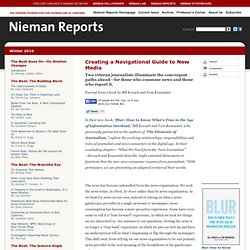
In their concluding chapter—“What We Need from the ‘Next Journalism’”—Kovach and Rosenstiel describe “eight essential dimensions or functions that the new news consumer requires from journalism.” With permission, we are presenting an adapted version of their words. The news has become unbundled from the news organization. We seek the news today, in effect, by story rather than by news organization. The Public Laboratory. Part 3: Tumblr Serves “5.3 Billion Views Per Month,” Explains Mark Coatney [Video]
Geo-Location Services Provide New Opportunities for News. Knowing where someone is as they consume media can be a powerful tool in the hands of a journalist, publisher or advertiser.

And as use of GPS-equipped mobile devices has grown, so has interest in and competition to provide location-based services such as tailored news and information, advertisements, coupons, travel guides and more. Recently, it seems like every digital media and advertising conference has sessions about things like “geo-location” and how to provide local services on mobile devices. The Ad:Tech conference earlier this month in New York, for example, had three geo-location seminars with executives from: Geo-location services Foursquare, Loopt and Gowalla, all of which let users “check in” from where they are, give and receive recommendations, receive rewards and communicate with friends on the services.
Notably absent from the panels was Facebook. The promise Deals and its competitors are providing has been a holy grail of marketing. Opportunities for News Organizations. Teaching mobile journalism: It’s not just the tools, it’s the mindset. April 05, 2011 Mobile is playing an increasingly important role in how people access the internet and keep up with what’s happening.

How can journalism schools prepare the next generation of journalists to use mobile tools and media well for reporting, publishing, and engagement? 7 Ways Journalists Can Use Foursquare. Tech-savvy journalists usually go where the crowds are, and were quick to jump on Facebook, LinkedIn, and Twitter.
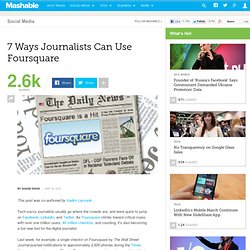
As Foursquare climbs toward critical mass, with over one million users, 40 million checkins, and counting, it's also becoming a hot new tool for the digital journalist. Last week, for example, a single checkin on Foursquare by The Wall Street Journal pushed notifications to approximately 2,600 phones during the Times Square evacuation scare. Clearly, Foursquare can no longer be considered just a game. With all the recent hype, journalists and media companies are itching to find their own ways to use location-sharing apps to bolster their trade. You can get started with the following seven tips, then share your own ideas in the comments. 1.
Foursquare pegs real people to real places. @SREE'S SOCIAL MEDIA GUIDE - a work in progress. Create stories using social media - storify.com. NewsCloud. EveryBlock. Publish2′s Ryan Sholin: “We did not set out to kill the Associated Press”